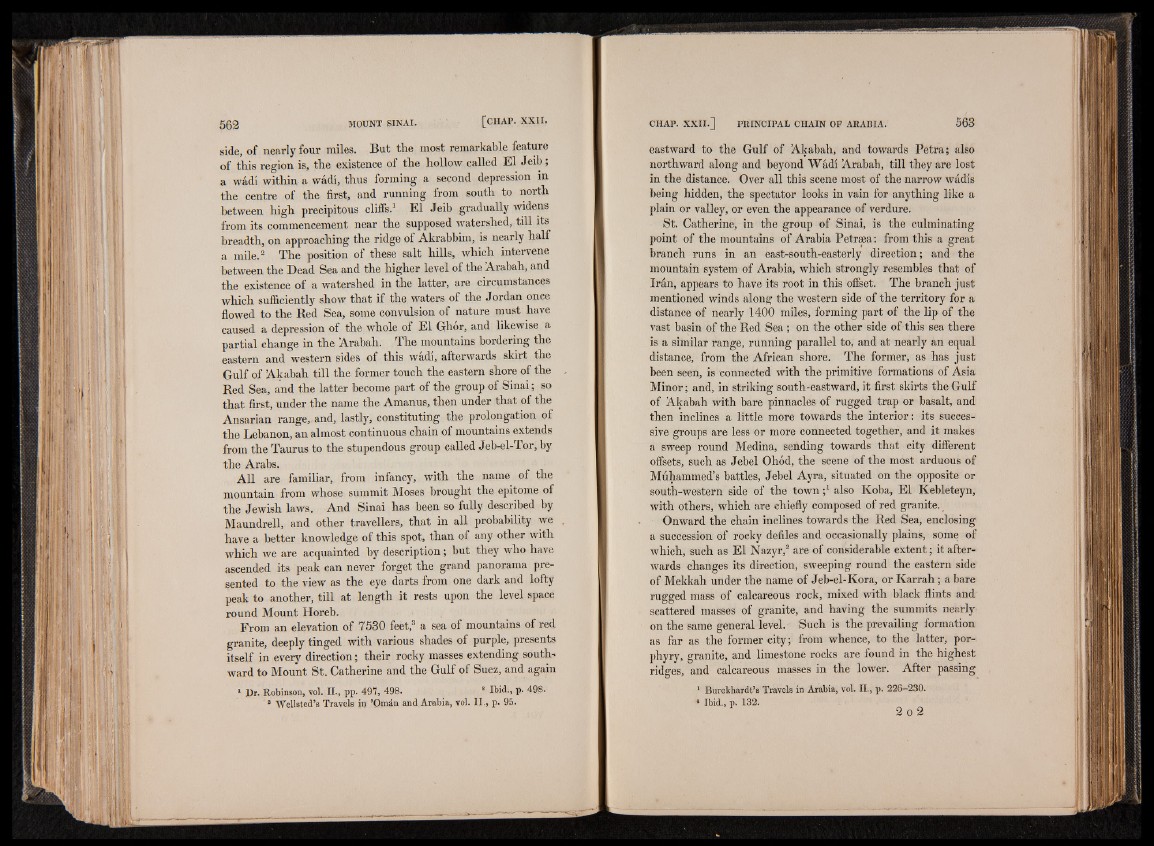
side, of nearly four miles. But tlie most remarkable feature
of this region is, the existence of the hollow called El Jeib;
a wádí within a wadi, thus forming a second depression in
the centre of the first, and running from south to north
between high precipitous cliffs.1 El Jeib gradually widens
from its commencement near the supposed watershed, till its
breadth, on approaching the ridge of Akrabbim, is nearly half
a mile.2 The position of these salt hills, which intervene
between the Dead Sea and the higher level of the Arabah, and
the existence of a watershed in the latter, are circumstances
which sufficiently show that if the waters of the Jordan once
flowed to the Red Sea, some convulsion of nature must have
caused a depression of the whole of El Ghor, and likewise a
partial change in the Arabah. The mountains bordering the
eastern and western sides of this wadi, afterwards skirt the
Gulf of Akabah till the former touch the eastern shore of the
Red Sea, and the latter become part of the group of Sinai; so
that first, under the name the Amanus, then under that of the
Ansarian range,,and, lastly, constituting the prolongation of
the Lebanon, an almost continuous chain of mountains extends
from the Taurus to the stupendous group called Jeb-el-Tor, by
the Arabs.
All are familiar, from infancy, with the name of the
mountain from whose summit Moses brought the epitome of
the Jewish laws. And Sinai has been so fully described by
Maundrell, and other travellers, that in all probability we
have a better knowledge of this spot, than of any other with
which we are acquainted by description; but they who have
ascended its peak can never forget the grand panorama presented
to the view as the eye darts from one dark and lofty
peak to another, till at length it rests upon the level space
round Mount Horeb.
From an elevation of 7530 feet,3 a sea of mountains of red
granite, deeply tinged with various shades of purple, presents
itself in every direction; their rocky masses extending southward
to Mount St. Catherine and the Gulf of Suez, and again
1 Dr. Robinson, vol. II., pp. 497, 498. 2 Ibid., p. 49.8.
3 Wellsted’s Travels ip ’Omán and Arabia, vol. II., p. 95.
eastward to the Gulf of Akabah, and towards Petra; also
northward along and beyond Wadi Arabah, till they are lost
in the distance. Over all this scene most of the narrow wadis
being hidden, the spectator looks in vain for anything like a
plain or valley, or even the appearance of verdure.
St. Catherine, in the group of Sinai, is the culminating
point of the mountains of Arabia Petreea: from this a great
branch runs in an east-south-easterly direction; and the
mountain system of Arabia, which strongly resembles that of
Iran, appears to have its root in this offset. The branch just
mentioned winds along the western side of the territory for a
distance of nearly 1400 miles, forming part of the lip of the
vast basin of the Red Sea; on the other side of this sea there
is a similar range, running parallel to, and at nearly an equal
distance, from the African shore. The former, as has just
been seen, is connected with the primitive formations of Asia
Minor; and, in striking south-eastward, it first skirts the Gulf
of Akabah with bare pinnacles of rugged trap or basalt, and
then inclines a little more towards the interior: its successive
groups are less or more connected together, and it makes
a sweep round Medina, sending towards that city different
offsets, such as Jebel Ohod, the scene of the most arduous of
Muhammed’s battles, Jebel Ayra, situated on the opposite or
south-western side of the town j1 also Koba, El Kebleteyn,
with others, which are chiefly composed of red granite. B
Onward the chain inclines towards the Red Sea, enclosing
a succession of rocky defiles and occasionally plains, some of
which, such as El Nazyr,2 are of considerable extent; it afterwards
changes its direction, sweeping round the eastern side
of Mekkah under the name of Jeb-el-Kora, or Karrah; a bare
rugged mass of calcareous rock, mixed with black flints and
scattered masses of granite, and having the summits nearly
on the same general level. Such is the prevailing formation
as far as the former city; from whence, to the latter, porphyry,
granite, and limestone rocks are found in the highest
ridges, and calcareous masses in the lower. After passing
1 Burekhardt’s Travels in Arabia, vol. II., p. 226-230.
8 Ibid., p. 132.